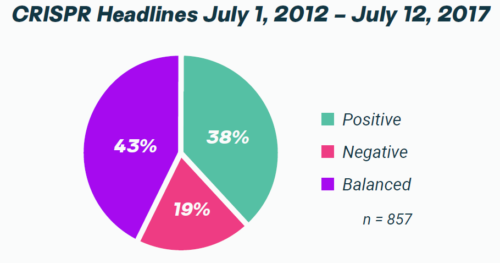The Annenberg Public Policy Center has released a pair of Science Media Monitor reports analyzing how the news media cover two important issues in science — gene editing and scientific retractions.
One of the reports examines how the news media framed stories about ethical issues surrounding the controversial gene-editing technology CRISPR/Cas9, starting with its earliest appearances in the press. The other considers how the media covered scientific studies that have been retracted, focusing on three high-profile examples.
These are the second and third reports of the Annenberg Science Media Monitor, a project of APPC’s Science of Science Communication program. The Science Media Monitor, directed by APPC Director Kathleen Hall Jamieson, is supported by a grant from the Rita Allen Foundation.
CRISPR and ethical concerns
The CRISPR report looked at the headlines of 857 articles from mid-2012 to mid-2017 that mentioned CRISPR/Cas9 and ethics. Coverage about CRISPR and ethics was more often framed positively (38 percent) or as balanced (43 percent) than negatively (19 percent). Coverage spiked in December 2015, when the National Academies of Sciences, Engineering, and Medicine convened a summit on gene editing and when Congress voted to prevent public funds from being used to review drugs or biological products related to germline editing.
Click here for the report Media Framing of News Stories About the Ethics, Benefits, and Risks of CRISPR/Cas9.

Coverage of scientific retractions
The third Annenberg Science Media Monitor focuses on news coverage of three high-profile retracted scientific findings, those of:
- Miguel Ángel Martínez González, whose paper, “Primary Prevention of Cardiovascular Disease with a Mediterranean Diet,” was published in February 2013 in The New England Journal of Medicine;
- Oona Lönnstedt and Peter Eklöv, whose paper, “Environmentally relevant concentrations of microplastic particles influence larval fish ecology,” was published in June 2016 in Science;
- Brian Wansink, who has had a number of papers on human eating behavior retracted, including “Bad popcorn in big buckets: portion size can influence intake as much as taste,” published in September 2005 in The Journal of Nutrition Education and Behavior.
News pieces about retractions treat those due to unintended error differently than those withdrawn for malfeasance or fraud. This report looks at one of the former (Mediterranean diet), which attributed the retractions to researcher error rather than intentional deception, and two of the latter. Reporting on the Lönnstedt-Eklöv study and on Wansink’s numerous withdrawn papers adopted the counterfeit quest narrative, chronicling the activities of a deceptive researcher who has gulled custodians of knowledge such as journal editors and peer reviewers.

The APPC analysis involved 172 print and digital news articles from 2016-2018 about one of those retractions. The report found that:
- 97 percent of the news stories involving one of the three retractions report the circumstances leading to retractions;
- 49 percent report how the errors or misconduct were identified;
- 3 percent outline steps that the scientific community has taken to prevent future research mismanagement or misconduct;
- 2 percent say that retractions are evidence of the self-correction process at work in science;
- 95 percent avoid generalizing from a few retractions to conclude that science is broken or in crisis.
Click here for the report How the Media Frame News Stories About Retractions of Scientific Findings.


